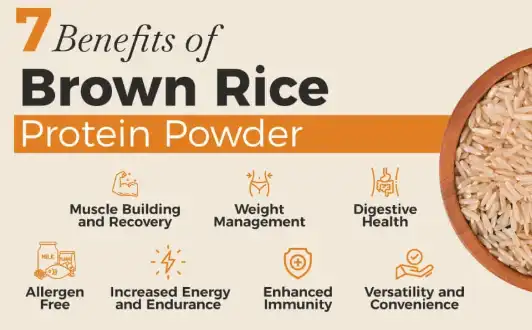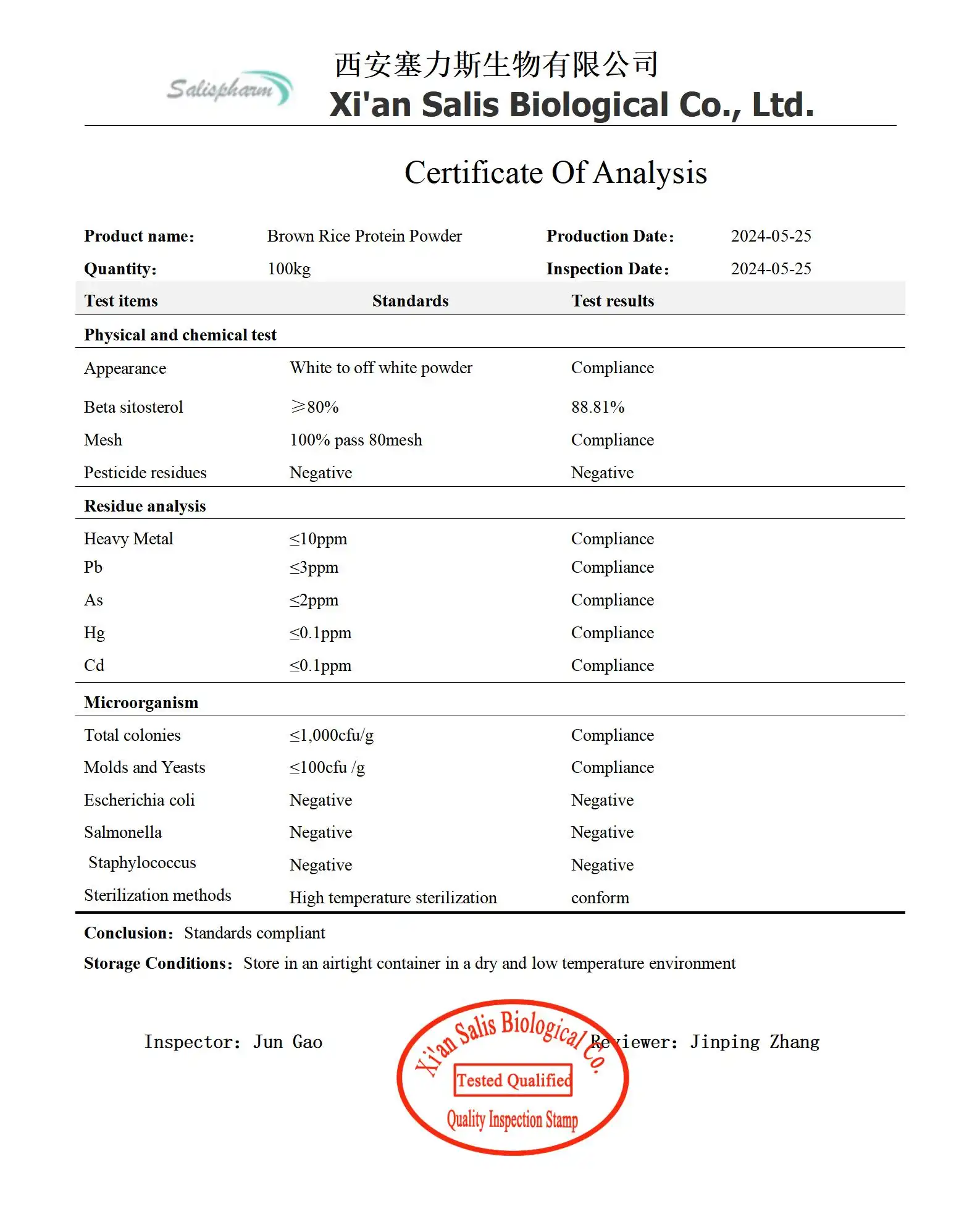In the world of fitness and nutrition, protein maquillages have come decreasingly popular as a means to support muscle growth and recovery. Among the colorful options available, Brown Rice Protein Powder has gained attention as a factory- grounded volition to traditional whey protein. This composition explores the implicit benefits of brown rice protein greasepaint for muscle growth and addresses some common questions girding its use in fitness routines.

What Are the Nutritional Benefits of Brown Rice Protein Powder?
Amino Acid Profile of Brown Rice Protein
Brown Rice Protein Powder is derived from whole grain brown rice and offers a complete amino acid profile, which is essential for muscle growth and form. While it contains all nine essential amino acids, it's particularly rich in methionine and cysteine. These sulfur- containing amino acids play vital places in various fleshly functions, including protein emulsion and antioxidant product. The amino acid composition of brown rice protein cream makes it a doable option for individualities looking to support muscle growth through plant- predicated sources. still, it's worth noting that the leucine content, a pivotal amino acid for muscle protein emulsion, is slightly lower in brown rice protein compared to whey protein. Despite this, studies have shown that brown rice protein can still effectively stimulate muscle protein emulsion when consumed in respectable amounts.
Digestibility and Absorption of Brown Rice Protein
One of the advantages of brown rice protein greasepaint is its high insipidity. The protein is fluently broken down and absorbed by the body, allowing for effective application of its amino acids. This specific is particularly salutary for individualities with sensitive digestive systems or those who may witness discomfort with dairy- grounded proteins. The insipidity of brown rice protein greasepaint is farther enhanced through the processing styles used to produce the greasepaint, which frequently involve enzymatic treatments to ameliorate protein quality and immersion. As a result, brown rice protein greasepaint can be an excellent choice for those seeking a fluently digestible protein source to support muscle growth and recovery. also, the lack of common allergens in brown rice protein makes it a suitable option for individualities with food perceptivity or disinclinations.
Micronutrient Content in Brown Rice Protein Powder
Beyond its protein content, brown rice protein greasepaint also offers a range of micronutrients that can contribute to overall health and fitness. It's a good source of B vitamins, particularly thiamin, niacin, and vitamin B6, which are important for energy metabolism and muscle function. Brown rice protein greasepaint also contains minerals similar as iron, magnesium, and phosphorus, which play pivotal places in colorful physiological processes, including oxygen transport, muscle compression, and bone health. The presence of these micronutrients in brown rice protein greasepaint can give fresh nutritive benefits beyond just protein supplementation. still, it's important to note that the micronutrient content may vary depending on the processing styles and the specific brown rice variety used. To insure you are getting the most nutritive benefit, it's judicious to choose a high- quality brown rice protein greasepaint from a estimable manufacturer.
How Does Brown Rice Protein Compare to Other Protein Sources for Muscle Building?
Brown Rice Protein vs. Whey Protein
When comparing Brown Rice Protein Powder to whey protein, the gold standard in muscle structure supplements, several factors come into play. Whey protein is known for its rapid-fire immersion and high leucine content, which makes it particularly effective for stimulating muscle protein conflation. still, studies have shown that brown rice protein can be inversely effective in promoting muscle growth and strength earnings when consumed in original quantities. A notable 8- week study set up that actors who supplemented with brown rice protein endured analogous increases in muscle mass and strength compared to those using whey protein. This suggests that brown rice protein greasepaint can be a feasible volition for individualities seeking factory- grounded options without compromising on muscle- structure eventuality. also, brown rice protein may offer benefits in terms of insipidity and reduced allergenicity for those who are sensitive to dairy products.
Brown Rice Protein vs. Other Plant-Based Proteins
In the realm of factory- grounded proteins, brown rice protein stands out for its complete amino acid profile and high insipidity. When compared to other popular factory proteins like pea, hemp, or soy, brown rice protein offers a balanced nutritive profile that can effectively support muscle growth. While pea protein is known for its high leucine content, brown rice protein excels in methionine and cysteine. This reciprocal amino acid profile means that combining brown rice protein with other factory proteins can produce a further comprehensive amino acid mix. For case, a combination of brown rice and pea protein can give a well- rounded amino acid profile that nearly mimics that of beast- grounded proteins. This synergistic approach can be particularly salutary for insectivores and insectivores looking to optimize their protein input for muscle growth and recovery.
Bioavailability and Absorption Rates
The bioavailability and immersion rates of protein sources are pivotal factors in determining their effectiveness for muscle growth. Brown rice protein greasepaint has been shown to have a high bioavailability, meaning that a significant portion of its amino acids are readily absorbed and employed by the body. While it may not be absorbed as fleetly as whey protein, the slower digestion rate of brown rice protein can give a more sustained release of amino acids into the bloodstream. This prolonged amino acid vacuity can be salutary for maintaining muscle protein conflation over extended ages, particularly during fasting or between refections. likewise, the hypoallergenic nature of brown rice protein makes it less likely to beget digestive discomfort or antipathetic responses compared to some other protein sources. This specific can be particularly profitable for individualities with sensitive digestive systems or those prone to food disinclinations, allowing them to constantly consume acceptable protein for muscle growth without adverse goods.
What Are the Potential Side Effects and Considerations When Using Brown Rice Protein Powder?
Digestive Tolerance and Allergenicity
One of the primary considerations when using brown rice protein greasepaint is its impact on digestive health. Generally, brown rice protein is well- permitted by utmost individualities and is less likely to beget digestive discomfort compared to some other protein sources. Its hypoallergenic nature makes it an excellent choice for those with dairy or soy disinclinations. still, as with any salutary supplement, some people may witness mild digestive issues similar as bloating or gas when first introducing brown rice protein greasepaint into their diet. These goods are generally temporary and frequently resolve as the body adjusts to the new protein source. To minimize implicit digestive discomfort, it's judicious to start with lower servings and gradationally increase the quantum over time. also, icing proper hydration when consuming protein maquillages can help grease digestion and reduce the liability of gastrointestinal torture.
Potential Heavy Metal Contamination
A concern that has been raised regarding rice-based products, including brown rice protein powder, is the potential for heavy metal contamination, particularly arsenic. Rice plants have a tendency to absorb arsenic from soil and water more readily than other crops. While this is a valid concern, it's important to note that reputable manufacturers of brown rice protein powder typically employ rigorous testing and purification processes to ensure their products meet safety standards for heavy metal content. Consumers can look for products that have been third-party tested for contaminants and choose brands that are transparent about their sourcing and production methods. It's also worth considering that the overall arsenic exposure from brown rice protein powder, when consumed as part of a varied diet, is generally low. However, individuals who consume large amounts of rice-based products may want to diversify their protein sources to minimize potential risks.
Balancing Nutrient Intake
While brown rice protein greasepaint can be an excellent source of factory- grounded protein, it's pivotal to consider its part within a balanced diet. counting solely on any single protein source, including brown rice protein, may lead to imbalances in nutrient input. Brown rice protein is fairly low in lysine compared to some other protein sources, so it's salutary to consume a variety of protein-rich foods to insure a complete amino acid profile. also, brown rice protein greasepaint should n't be used as a cover for whole food protein sources, which give a wider range of nutrients and fiber. When incorporating brown rice protein greasepaint into your diet, it's important to consider your overall protein needs grounded on factors similar as body weight, exertion position, and fitness pretensions. Consulting with a nutritionist or dietitian can help you determine the applicable quantum of protein supplementation for your individual requirements and insure that your use of brown rice protein greasepaint complements a well- rounded, nutrient- thick diet.
Conclusion
Brown rice protein powder has emerged as a promising plant-based option for supporting muscle growth and overall fitness goals. Its complete amino acid profile, high digestibility, and hypoallergenic nature make it a versatile choice for a wide range of individuals, including those with dietary restrictions or sensitivities. While it may not match the rapid absorption of whey protein, studies have shown that brown rice protein can be equally effective in promoting muscle gains when consumed in adequate amounts. As with any dietary supplement, it's important to consider potential side effects and use brown rice protein powder as part of a balanced, varied diet. By understanding its benefits and limitations, individuals can make informed decisions about incorporating brown rice protein powder into their nutrition plan to support muscle growth and overall health.
If you are also interested in this product and want to know more product details, or want to know about other related products, please feel free to contact lea_slsbio@163.com,WhatsApp+86 13193326505.

References
1. Joy, J. M., et al. (2013). The effects of 8 weeks of whey or rice protein supplementation on body composition and exercise performance. Nutrition Journal, 12(1), 86.
2. Kalman, D. S. (2014). Amino Acid Composition of an Organic Brown Rice Protein Concentrate and Isolate Compared to Soy and Whey Concentrates and Isolates. Foods, 3(3), 394-402.
3. Babault, N., et al. (2015). Pea proteins oral supplementation promotes muscle thickness gains during resistance training: a double-blind, randomized, Placebo-controlled clinical trial vs. Whey protein. Journal of the International Society of Sports Nutrition, 12(1), 3.
4. Gorissen, S. H., et al. (2018). Protein content and amino acid composition of commercially available plant-based protein isolates. Amino Acids, 50(12), 1685-1695.
5. Banaszek, A., et al. (2019). The Effects of Whey vs. Pea Protein on Physical Adaptations Following 8-Weeks of High-Intensity Functional Training (HIFT): A Pilot Study. Sports, 7(1), 12.
6. Amtmann, J., et al. (2020). Comparison of the effects of whey and rice protein on physiological and performance parameters in resistance-trained men. Nutrients, 12(6), 1711.

